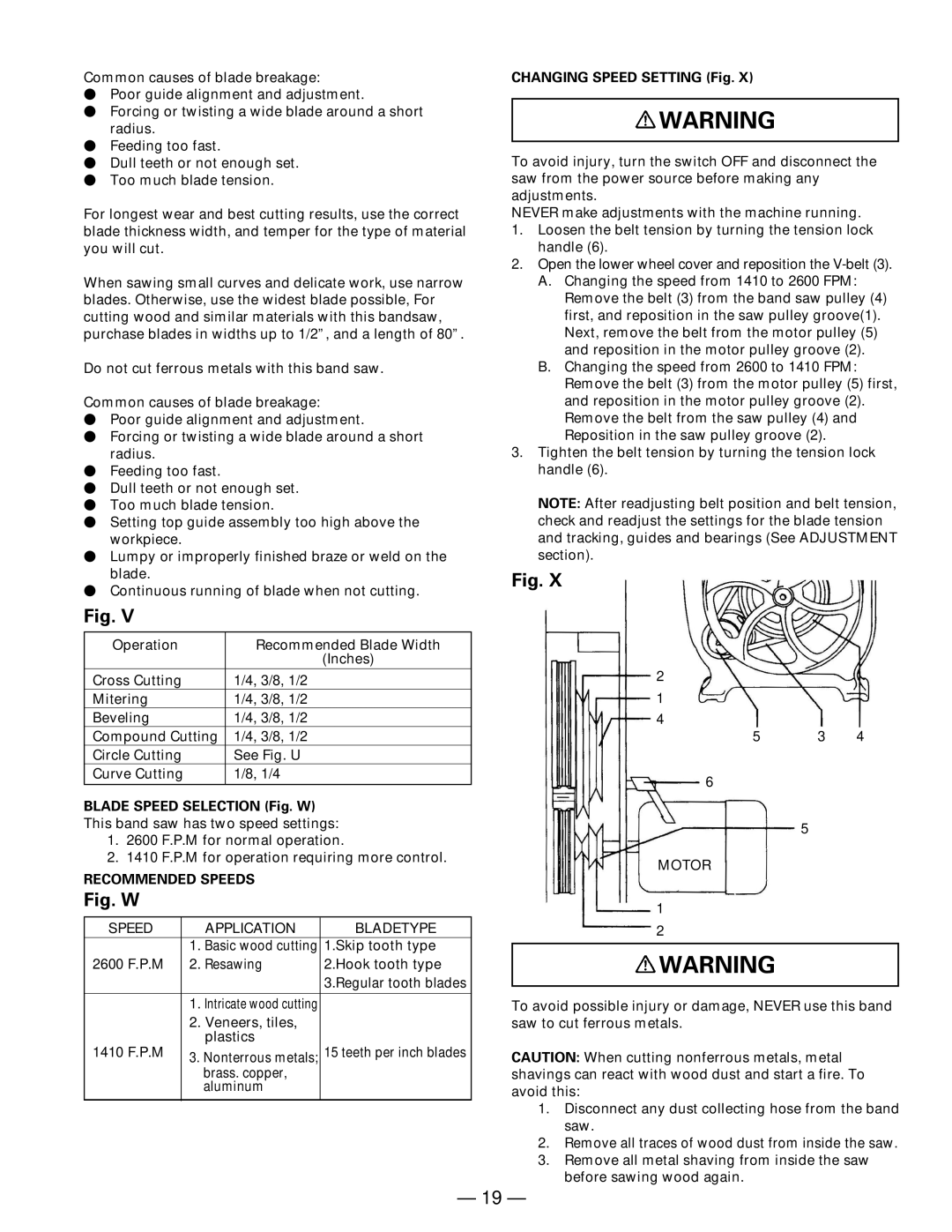
Common causes of blade breakage:
⬤Poor guide alignment and adjustment.
⬤Forcing or twisting a wide blade around a short radius.
⬤Feeding too fast.
⬤Dull teeth or not enough set.
⬤Too much blade tension.
For longest wear and best cutting results, use the correct blade thickness width, and temper for the type of material you will cut.
When sawing small curves and delicate work, use narrow blades. Otherwise, use the widest blade possible, For cutting wood and similar materials with this bandsaw, purchase blades in widths up to 1/2”, and a length of 80”.
Do not cut ferrous metals with this band saw.
Common causes of blade breakage:
⬤Poor guide alignment and adjustment.
⬤Forcing or twisting a wide blade around a short radius.
⬤Feeding too fast.
⬤Dull teeth or not enough set.
⬤Too much blade tension.
⬤Setting top guide assembly too high above the workpiece.
⬤Lumpy or improperly finished braze or weld on the blade.
⬤Continuous running of blade when not cutting.
Fig. V
Operation | Recommended Blade Width |
| (Inches) |
Cross Cutting | 1/4, 3/8, 1/2 |
Mitering | 1/4, 3/8, 1/2 |
Beveling | 1/4, 3/8, 1/2 |
Compound Cutting | 1/4, 3/8, 1/2 |
Circle Cutting | See Fig. U |
Curve Cutting | 1/8, 1/4 |
|
|
BLADE SPEED SELECTION (Fig. W)
This band saw has two speed settings:
1.2600 F.P.M for normal operation.
2.1410 F.P.M for operation requiring more control.
RECOMMENDED SPEEDS
Fig. W
SPEED | APPLICATION | BLADETYPE |
| 1. Basic wood cutting | 1.Skip tooth type |
2600 F.P.M | 2. Resawing | 2.Hook tooth type |
|
| 3.Regular tooth blades |
|
|
|
| 1. Intricate wood cutting |
|
| 2. Veneers, tiles, |
|
1410 F.P.M | plastics | 15 teeth per inch blades |
3. Nonterrous metals; | ||
| brass. copper, |
|
| aluminum |
|
|
|
|
CHANGING SPEED SETTING (Fig. X)
![]() WARNING
WARNING
To avoid injury, turn the switch OFF and disconnect the saw from the power source before making any adjustments.
NEVER make adjustments with the machine running.
1.Loosen the belt tension by turning the tension lock handle (6).
2.Open the lower wheel cover and reposition the
A.Changing the speed from 1410 to 2600 FPM: Remove the belt (3) from the band saw pulley (4) first, and reposition in the saw pulley groove(1). Next, remove the belt from the motor pulley (5) and reposition in the motor pulley groove (2).
B.Changing the speed from 2600 to 1410 FPM: Remove the belt (3) from the motor pulley (5) first, and reposition in the motor pulley groove (2). Remove the belt from the saw pulley (4) and Reposition in the saw pulley groove (2).
3.Tighten the belt tension by turning the tension lock handle (6).
NOTE: After readjusting belt position and belt tension, check and readjust the settings for the blade tension and tracking, guides and bearings (See ADJUSTMENT section).
Fig. X
2
1
4
5 3 4
6
5
MOTOR
1
2
![]() WARNING
WARNING
To avoid possible injury or damage, NEVER use this band saw to cut ferrous metals.
CAUTION: When cutting nonferrous metals, metal shavings can react with wood dust and start a fire. To avoid this:
1.Disconnect any dust collecting hose from the band saw.
2.Remove all traces of wood dust from inside the saw.
3.Remove all metal shaving from inside the saw before sawing wood again.
— 19 —
